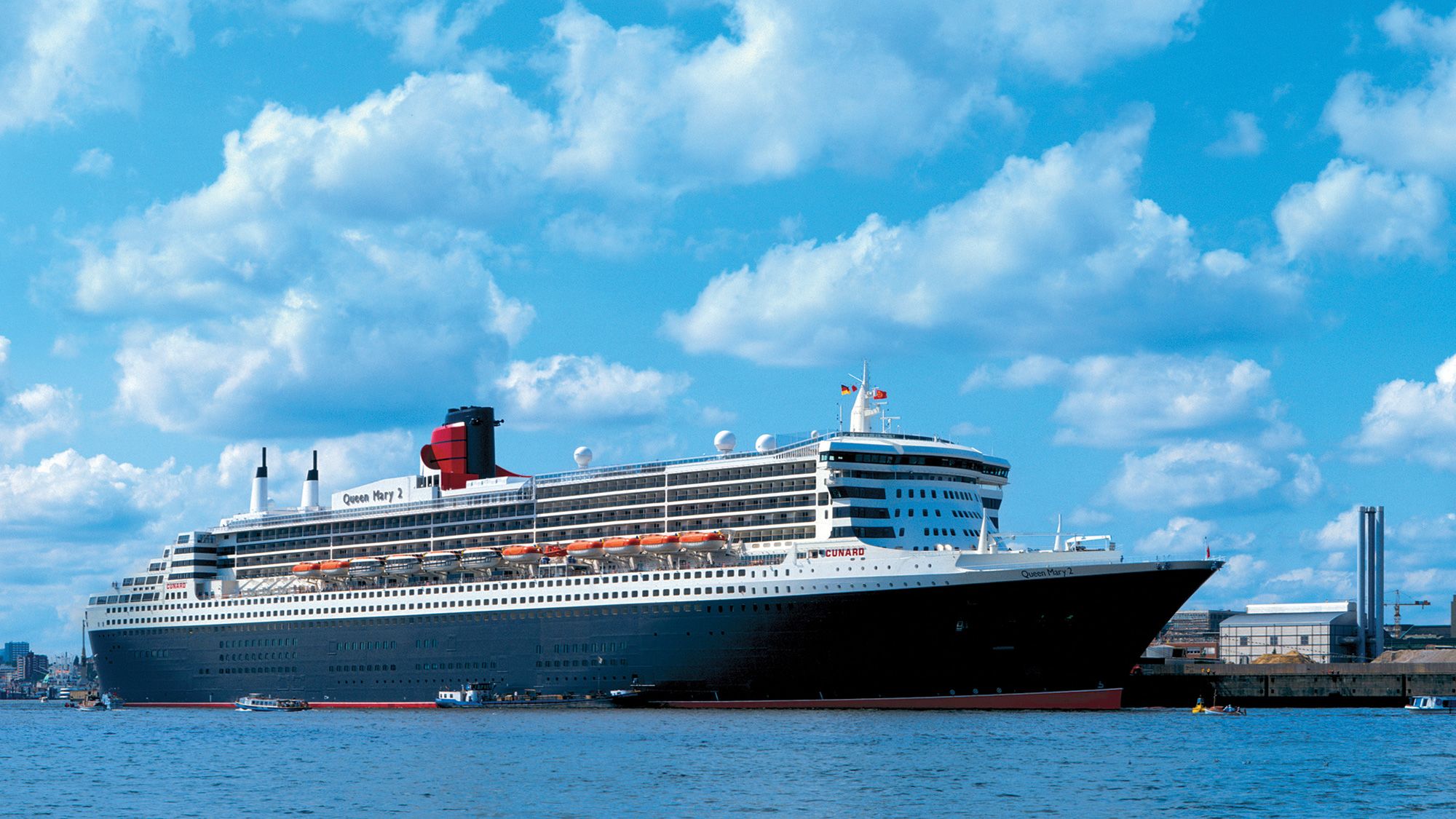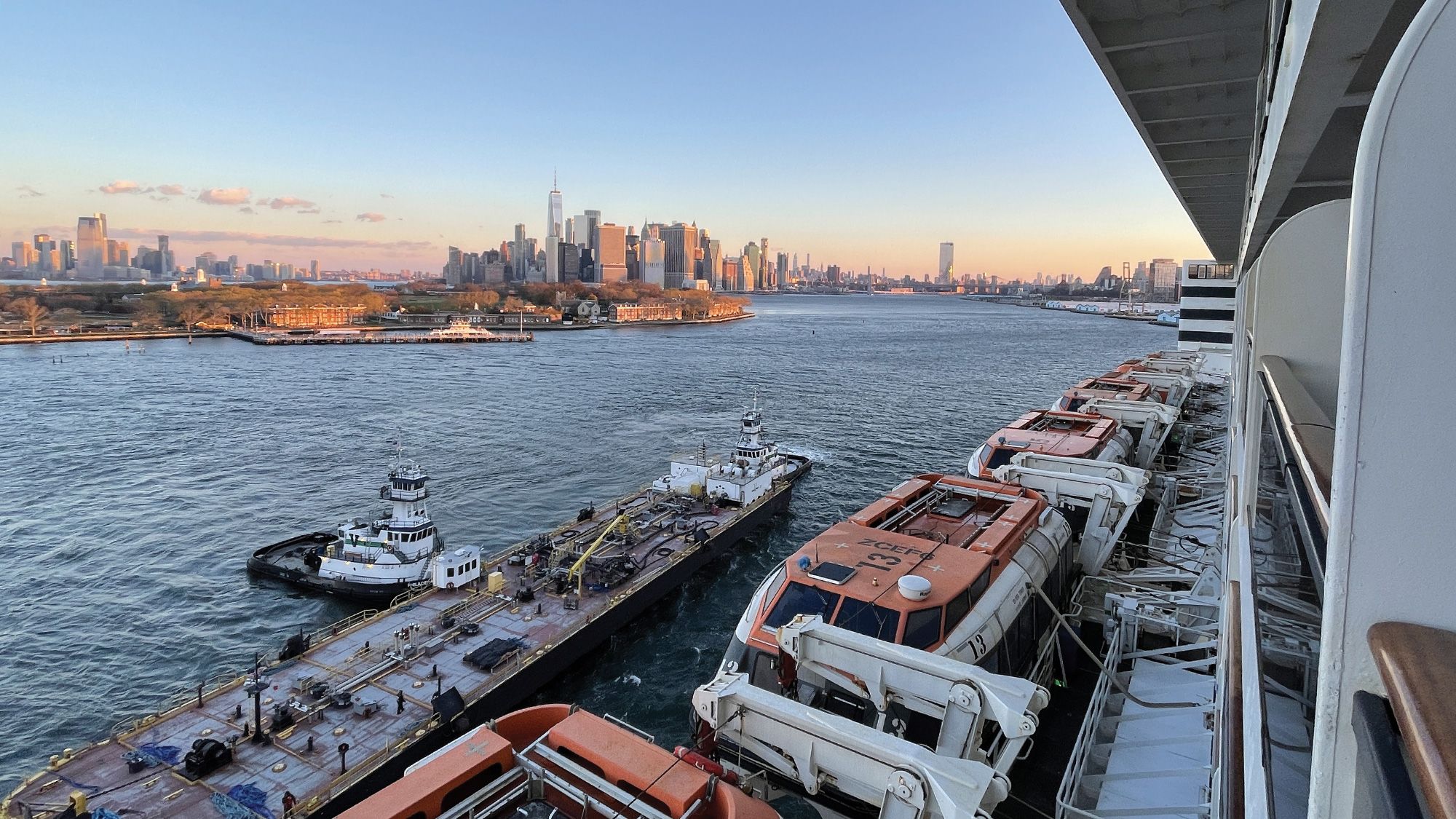Seeking
stormy seas
A winter transatlantic crossing on Cunard’s Queen Mary 2 will meet its fair share of wind, waves and rain. For some passengers on the ocean liner, the more tossing and turning, the better.

Do pets get seasick?
It’s a question I never imagined I would be asking, but on the third day of gale-force winds and stormy seas, my own motion-sick heart went out to the canines riding out the waves in the kennels at the very top of the ship.
The ship, of course, was Cunard’s Queen Mary 2, famous for its weeklong transatlantic passages from New York to Southampton, England, and back, which has the cruise industry’s only accommodations for pets.

A true ocean liner, the Queen Mary 2 was built to withstand gale-force winds and rough seas. (Courtesy of Cunard)
A true ocean liner, the Queen Mary 2 was built to withstand gale-force winds and rough seas. (Courtesy of Cunard)
My conversation with Oliver, the kennel master for more than a decade, confirmed that our weather was rougher than average and that a few pups were indeed a bit green, which he treated with natural remedies. But the abnormal conditions aren’t unheard of, especially in November when wintry weather begins to brew over the unpredictable Atlantic Ocean.
This crossing, as Cunard calls these sailings, departed Nov. 13 from Southampton. I was onboard to experience not only my first transatlantic voyage but also to attend Cunard’s Greatest Generations Foundation theme cruise, which landed on Remembrance Day in the U.K. (which falls just after Veterans Day here) and honors veterans with a series of hosted discussions.

World War II veterans Steve Melnikoff and Donald Cobb were onboard the Queen Mary 2 as part of the Greatest Generations Foundation theme cruise. (Photo by Brittany Chrusciel)
World War II veterans Steve Melnikoff and Donald Cobb were onboard the Queen Mary 2 as part of the Greatest Generations Foundation theme cruise. (Photo by Brittany Chrusciel)
Equipped with Bonine pills, I was prepared for some motion but unprepared for the stretch of three days that blurred together in what felt like an elegant washing machine. The skies parted and the seas calmed briefly on Day 4, with passengers emerging to feel the sun and breathe in the air. We were tossed much more gently for the remainder of the crossing.
For reference, passengers on a winter crossing (November through January) can expect moderate winds and possibly 13-to-14-foot seas. Our sailing experienced prolonged periods of dangerous winds (55 to 60 knots over the deck) and 18-to-24-foot seas. Outside was an almost blinding gray, and waves occasionally smacked the windows of the lower decks with dramatic effect. Because of this, the outer decks were closed to passengers on and off throughout the cruise.
But the QM2, considered an ocean liner, is specifically built to withstand heavy winds and seas, with a reinforced steel bow that pushes away the waves, lifted lifeboats and a design around the bridge and bulkhead that provides a superior windscreen. The vessel can maintain speed — and a certain level of equilibrium, which usually enables guests to continue about their sea days, throwing darts or knocking back pints in the Golden Lion pub.
In fact, most activities on the QM2’s daily program continued through gale-force 9 winds, apart from stage performances — for the safety of the performers — and the planetarium, which involves the operation of a retractable dome. Ballroom dancing, rounds of trivia, learning German: It can all be done if feeling up to it. And from what I saw, guests were taking advantage of the ship’s public spaces to socialize.

The Queen Mary 2 slices through a storm during a transatlantic crossing in November. (Photo by Aaron Saunders)
The Queen Mary 2 slices through a storm during a transatlantic crossing in November. (Photo by Aaron Saunders)
Storm chasers
As it turns out, there are quite a few Cunard fans who prefer winter crossings — and the stormier the seas, the better.
“So much of the magic of the ship and a winter crossing is the heritage; they used to operate transatlantic sailings 12 months of the year,” said Ben Lyons, a former chief officer for Cunard Line and current CEO of Eyos Expeditions, a company that arranges luxury yacht charters. “On a transatlantic cruise, there’s the extra element of nostalgia and history, carrying on a tradition of ships crossing the North Atlantic from the Old World to the New World in all seasons; it’s almost the antithesis of your typical Caribbean cruise.”
Lyons and his family regularly book the December crossing, due in part to a December birthday in the family. He says that the sailing is more popular now with bookers seeking cozy, holiday decor, and was much harder to sell 20 or 30 years ago.
Back then, Lyons said, the Queen Elizabeth 2 would take the shortest route across, a five-day journey, at times forcing the ship to sail through inclement weather. Now, with a seven-day crossing, there is more flexibility to avoid particularly rough seas.
“I would book the QE2 crossing hoping for bad weather,” Lyons recalled. “The captain at the time would make comments during the daily noon announcement, specifically addressing the crowd who was looking for a bit of a storm.”
Lyons admits the storm-chasing cruisers are individuals familiar with being at sea. “It’s a self-selecting audience,” he says of passengers who book a winter crossing. “The appeal is absolutely the weather. It’s fantastic to witness the seascape in a big storm; the raw power of nature is extraordinary to see, and the QM2 is built for this. It didn’t skimp on the hull or the design — the factors that make the ship a true ocean liner. For those of us who have sailed a transatlantic on the QE2, the QM2 is so stable in comparison.”
He said that expecting a bit of motion in the North Atlantic during the winter season should be obvious and added that for the most part, the ship avoids the worst of it.
“Anyone considering [a winter crossing] should do it,” Lyons said. “It’s a unique and wonderful maritime experience that captures a bygone era. A warmly lit ship against a cold, dark exterior. … A sailing on QM2 is the pinnacle of transatlantic crossings.”
Another group of travelers on winter crossings are those who can be found on Cunard ships year-round: people who don’t fly.
Sherry Laskin, a writer who focuses on cruise, is one of them and is part of a group of passengers who use the ship just as much for transportation as a vacation. Laskin has completed 22 crossings in all seasons, including a winter crossing on the Celebrity Constellation that endured what she called a “perfect storm” sailing from Dover, England, to Newfoundland in Canada, arriving with windows smashed and paint peeling from the bow.
“I slept in the lobby with a flashlight and a book,” she said of that cruise. “But don’t let the thought of rough seas in winter deter you from a crossing, especially on Queen Mary 2. This stellar ship can slice through 30-foot waves and 60 mph winds like a warm knife through butter.
“How bad can it be if the Brits on QM2 cheer whenever there’s a big wave?” she added.

Deck chairs tied down against North Atlantic winds on the ship’s promenade. (Photo by Brittany Chrusciel)
Deck chairs tied down against North Atlantic winds on the ship’s promenade. (Photo by Brittany Chrusciel)
Built for this
Hotel general manager David Shepherd recalled the narrow window in which the crew had to ensure departure from New York in late-October 2012, just before Superstorm Sandy moved in.
“The fastest I’ve been on this ship is 28 knots, and that was escaping Sandy,” Shepherd told me during a visit to his office on Deck 2. “I stood in this very window, and I was looking up at the waves high above me, and it was just unbelievable. It was quite an impressive moment to be on this ship, to see what it could do at full power.”
Aaron Saunders, a senior editor at Cruise Critic, was on that crossing and has continued to return to the QM2, going so far as to add a winter crossing to his travel to-do list; something he accomplished on this November sailing.
“I knew there was the possibility that the crossing could be stormy, but I wanted to book a winter crossing specifically so it could be colder, wetter, rougher — more adventurous and something out of the ordinary,” Saunders told me over ginger ales as we watched waves darken the Deck 2 windows.
“I wanted to see what the ship could do. We lost a ton of time with the rough seas … and we’ll still make it to New York on time, which is impressive.”
Like the royal who named the QM2, the late Queen Elizabeth II, the passengers and crew onboard proved to be of hearty stock, and they seemed either well aware of the potential for stormy conditions or impressively adaptable to the unexpected.
“I would do it again, because you don’t know what to expect,” Saunders said. “The Atlantic changes minute to minute and day to day. A transatlantic is a humbling experience that shows you the power of the North Atlantic that you wouldn’t get in any other way; the vastness, strength, and what it took people a century ago to make the same crossing in very different circumstances.
“We’re doing this in safety, but there was a certain amount of finger-crossing in 1840 when Cunard first set sail with its ship Britannia.”

The Queen Mary 2 arrived in New York on schedule despite the stormy weather. (Photo by Brittany Chrusciel)
The Queen Mary 2 arrived in New York on schedule despite the stormy weather. (Photo by Brittany Chrusciel)
